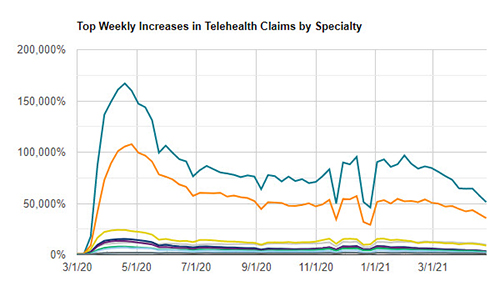As COVID-19 and social distancing concerns continue to impact healthcare delivery across the country, telehealth technology has emerged as the number one way to deliver care. Through remote patient evaluation, diagnosis, and treatment via telecommunication systems, providers deliver vital clinical services to patients – reducing care gaps and preventing exposure to the virus.
From addressing acute symptoms to managing chronic conditions and providing mental health support during these stressful times, physicians, nurse practitioners, physician assistants, and behavioral health professionals changed their established workflows in in a very short amount of time as the pandemic grew.
Access to telehealth services is particularly important in communities at high risk of poor outcomes due to COVID-19. Examples of this might be where a high percentage of the population is 60 years or older with two or more high-risk comorbidities and also regions that may lack critical care resources to help combat the impact of the virus, such as hospital or ICU capacity.
Telehealth Technology Implementation Trends
As the demand is surging, providers and other stakeholders are seeking to better understand how telehealth technology services are being adopted and used by various specialties across the country. In a rapidly evolving pandemic, real-time, comprehensive information is required for improved forecasting, allocation of resources, and clinical care delivery.
LexisNexis Risk Solutions’ COVID-19 Data Resource Center now includes telehealth trending insights. These insights demonstrate the overall change witnessed in telehealth claim volumes nationwide as well as the top national change in telehealth claim volumes by specialty – illustrating the weekly percent changes compared to last year’s claims.

Using a vast repository of current and past de-identified claims data to chart changes, LexisNexis is providing healthcare organizations and other health stakeholders access to current comprehensive telehealth trends for informed decision-making.
Telehealth Utilization Patterns
For example, as illustrated in our snapshot graphic, March saw the most significant increase in telehealth utilization from February to mid-April 2020 when compared to 2019 volumes. In particular, specialties showing the highest telehealth utilization increase were gastroenterology, orthopedic surgery, assistive therapy, urology, endocrinology, cardiology, anesthesiology, pediatrics, obstetrics/gynecology, and internal medicine.
As providers and patients alike continue to reduce their risks through virtual care amid the COVID-19 pandemic, de-identified claims data insights will continue to provide a clear line of sight into the nuances about telehealth technology utilization. These trends provide a complement to the county-level insights that show at-risk populations and the correlated gaps in provider and facility coverage on the resource center heat map.
Check back often for the most up-to-date insights and stay tuned for additional information about how our advanced data analytics are supporting the U.S. healthcare industry’s response to the COVID-19 pandemic.





